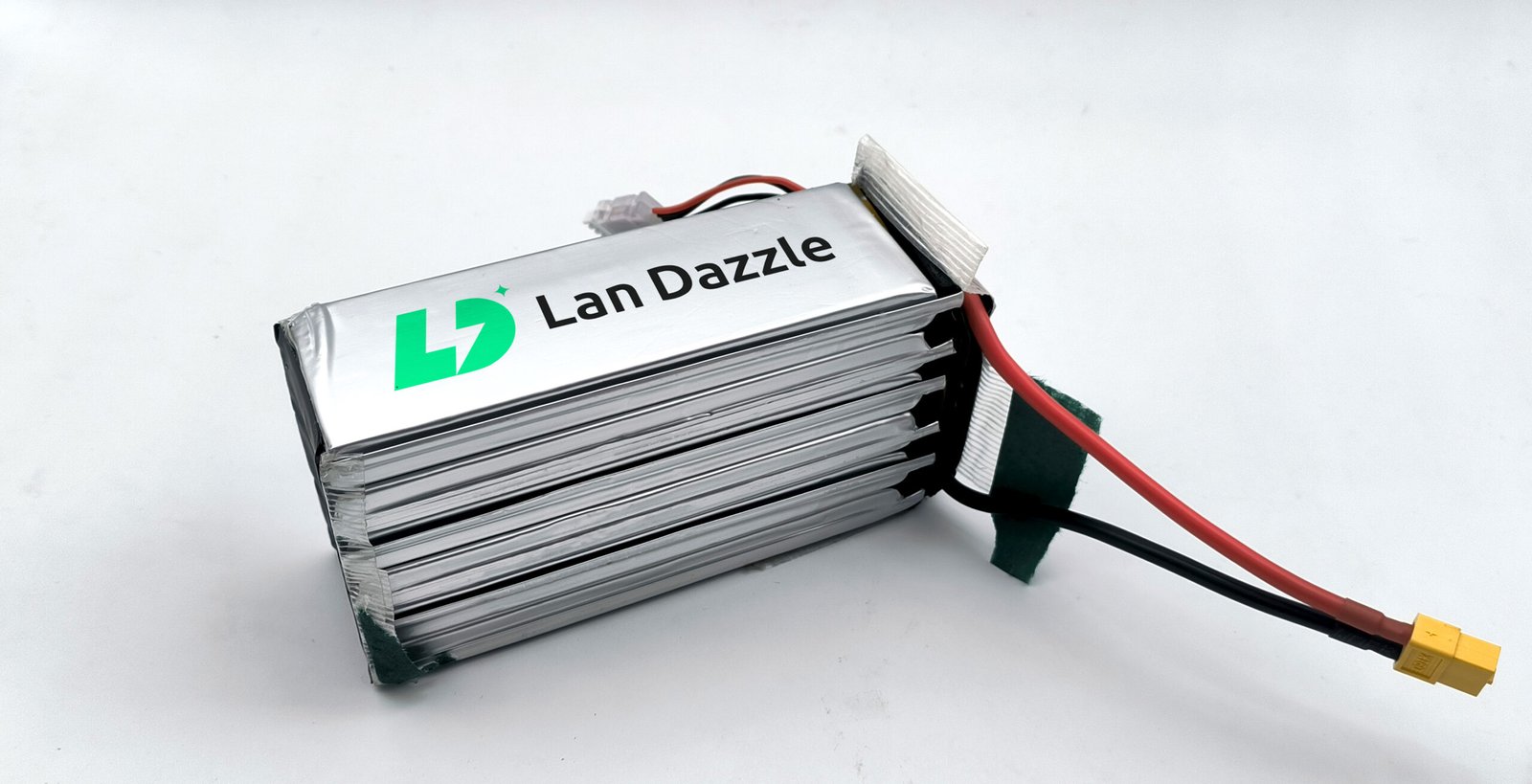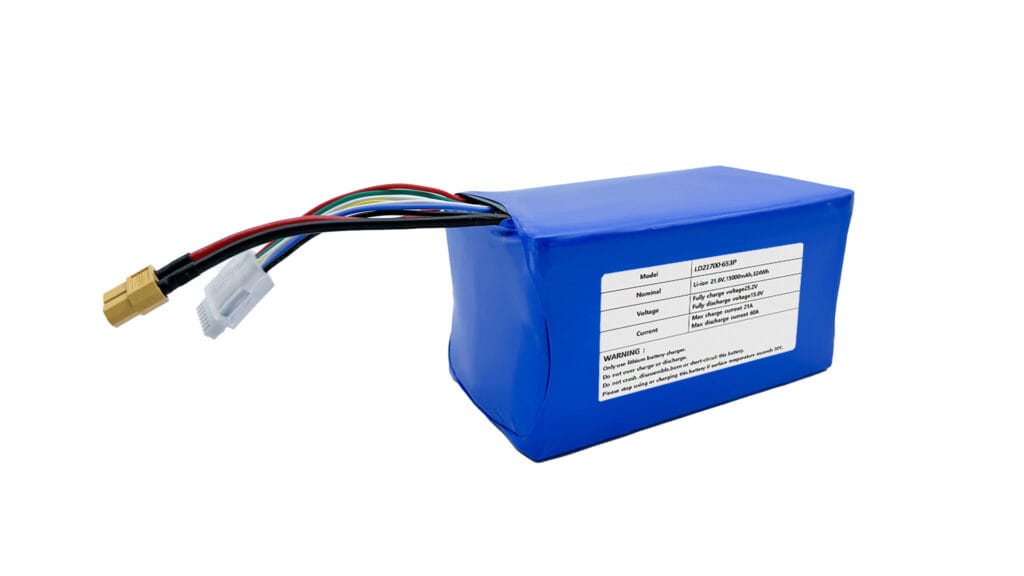What is the 6S LiPo Battery?
A battery lipo 6s consists of six individual LiPo cells connected in series (hence the “6S”), which results in a nominal voltage typically around 22.2V—this is often referred to as the 6s lipo battery voltage when each cell is at 3.7V nominal. This configuration is popular among hobbyists, remote-controlled (RC) enthusiasts, and professionals who require higher voltage battery packs for performance-demanding applications. Using a series connection allows for increased voltage output while maintaining the energy density benefits of LiPo technology.
Lan Dazzle Custom LiPo Battery Solutions
If you’re in the market for a customized power solution, Lan Dazzle is your go-to partner. They offer custom LiPo battery services designed to meet the specific needs of your application. Whether you require a robust battery pack for high-demand devices or a compact, flexible soft pouch battery for smaller, lightweight projects, Lan Dazzle has you covered.
-
Custom Battery Packs: Tailored for performance, safety, and longevity, these packs are perfect for RC models, robotics, and other applications where every volt counts.
-
Small Soft Pouch Batteries: Ideal for projects where space and weight are critical, offering the same high-quality performance in a more compact form factor.
For more information or to get started with your custom lithium battery project, contact us today at info@landazzle.com.
6S vs. Other LiPo Battery Configurations – Which One is Right for You?
When deciding between a 6s lipo battery and other LiPo battery configurations (such as 2S, 3S, 4S, or even 8S setups), several factors must be considered:
-
Voltage Requirements: Devices that require higher voltage typically benefit from a 6S configuration. Lower series configurations may be more suitable for applications that do not need as much power.
-
Weight and Space Constraints: Higher series configurations may increase the size and weight of the battery pack. Evaluate the available space and weight limitations of your device.
-
Performance Needs: High-performance applications (e.g., racing drones or high-speed RC cars) often demand the enhanced power output that a lipo battery 6s provides.
-
Cost Considerations: More complex battery packs can sometimes be more expensive. Weigh the cost against the performance benefits for your specific application.
Ultimately, the choice of battery configuration depends on the specific requirements of your project and the balance between performance, weight, cost, and safety.
Advantages of 6S LiPo Batteries
The benefits of using a 6s lipo battery are significant:
-
Higher Voltage Output: The series configuration delivers a higher voltage, which can provide more power and efficiency for motors and electronic devices that require it.
-
Enhanced Performance: Devices using a lipo battery 6s can experience improved acceleration, speed, and overall performance due to the increased power.
-
Better Energy Density: LiPo batteries are known for their high energy density, meaning that even in a 6S configuration, they maintain a favorable weight-to-power ratio.
-
Versatility: They are widely used in applications ranging from RC aircraft to electric vehicles, ensuring reliable performance under various conditions.
-
Improved Runtime: When properly managed, the higher voltage, often referenced as 6s lipo battery voltage, can contribute to longer runtime in applications that are optimized for such battery packs.
Applications of 6S LiPo Batteries
The 6s lipo battery finds extensive use in several areas:
-
Remote-Controlled (RC) Models: Including drones, airplanes, and cars that require higher power output for fast speeds and quick maneuvers. Many enthusiasts search for the best 6s lipo battery to get the most reliable performance.
-
Electric Vehicles: In smaller electric vehicles or e-bikes, where a higher voltage battery pack provides efficient power delivery.
-
Robotics: Robotics applications that need a compact yet high-voltage power source.
-
Portable Power Solutions: For applications such as portable generators and backup power systems.
-
Hobbyist Projects: Many DIY electronics and hobbyist projects incorporate 6S LiPo batteries for experimental and prototyping purposes.
Key Specifications to Consider When Choosing a 6S LiPo Battery
When selecting a 6s lipo battery for your project or device, consider these critical specifications:
-
Voltage and Capacity: Ensure the battery meets the voltage requirements of your device by checking the 6s lipo battery voltage and its capacity (measured in mAh) which determines how long the battery can run under load.
-
Discharge Rate (C-rating): The C-rating indicates how quickly the battery can safely discharge its stored energy. A higher C-rating is crucial for high-performance applications.
-
Weight and Dimensions: Consider the battery’s physical size and weight, as these factors can affect the balance and performance of the device.
-
Build Quality and Brand Reputation: Opt for reputable manufacturers to ensure quality, reliability, and safety. If you are searching online, look for reviews on the best 6s lipo battery options available.
-
Connector Type: Make sure the battery comes with the appropriate connectors for your device or that you can adapt them easily.
Charging and Safety Tips for 6S LiPo Batteries
Handling LiPo batteries, especially in a 6S configuration, requires careful attention to safety and proper charging practices:
-
Use a Compatible Charger: Ensure your charger is designed for 6S LiPo batteries. Using an incompatible charger can lead to overcharging or damage.
-
Balance Charging: Always use a balance charger to keep all cells equally charged, which helps extend the battery life and maintain performance.
-
Monitor Temperature: Avoid charging or discharging the battery in extreme temperatures. Overheating can lead to reduced battery life or safety hazards.
-
Storage Practices: Store your battery at the recommended storage voltage and in a cool, dry place when not in use.
-
Inspect Regularly: Periodically check the battery for any signs of damage, swelling, or other irregularities. Replace it if any issues are observed.
Following these tips can significantly reduce risks and ensure your lipo 6s battery performs optimally.
FAQs
-
How does a 6S LiPo battery differ from a 3S or 4S battery?
A 6S LiPo battery provides higher voltage by having more cells in series, which translates to more power and enhanced performance compared to lower series configurations. -
Can I use a 6S LiPo battery in my existing RC model?
It depends on the design and power requirements of your RC model. Always check the manufacturer’s specifications before making any changes. -
What is the typical lifespan of a 6S LiPo battery?
The lifespan can vary based on usage, charging practices, and storage conditions, but proper care can extend its life significantly. -
Are there any special storage considerations for a 6S LiPo battery?
Yes, it is important to store LiPo batteries at the recommended storage voltage, in a cool and dry place, to maintain their health over time. -
What should I do if my 6S LiPo battery shows signs of swelling or damage?
Immediately stop using the battery, disconnect it from any device, and follow proper disposal or recycling guidelines as provided by the manufacturer or local regulations.






